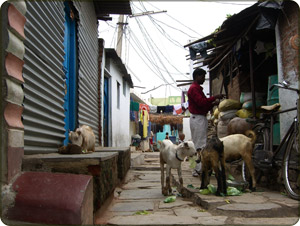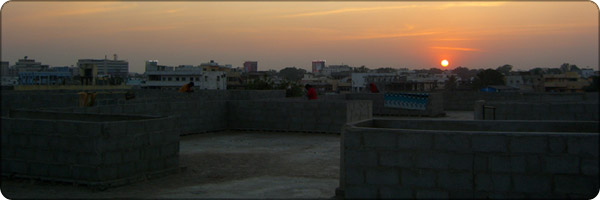Part 2 of a three part series on how to use homestays to jump-start a community-based entrepreneurial initiative. You can read Part 1 here.

An alleyway in Indiramma Nagar
"Can I talk to you about something?" Muneer asked me during one of our afternoon walks around the city.
It's May of 2006, the fifth week our BoP initiative with the Solae Company, and I was in the middle of a weeklong homestay in Indiramma Nagar - a cluster of slums by the Hyderabad airport. Muneer was a young Muslim resident who I had been introduced to on my first visit to the neighborhood. Every day I looked forward to his arrival at my hosts Baba and Sultana's home, a little wood and corrugated steel structure by the airport wall. Not only did Muneer's 5 PM visit herald the abatement of the sweat-boiling heat, but his near perfect English gave me someone to talk to, not to mention someone to explain to me what I may have done wrong. I recognized his question as a prelude to such an explanation.
"Of course," I replied, stepping to the side of the alley as a rickshaw rumbled by.
"What happened last night?" he asked.
Ah yes, that . . . Ilias and his brother. I told Muneer about Sultana encouraging me to go with the two boys, walking with them through the alleys to another home, pushing aside the front curtain, and then seeing the sudden reaction of the women and children lying on the floor – surprise, fear, anger. I had no idea what was going on but I knew it was wrong. I had bowed a quick apology and dragged the boys out the door, walking hurriedly back to my hosts.
"That naughty boy," Muneer replied after I finished describing what happened, "I told Ilias you could not stay with him, but he decided to take you home any way. It seems he told Sultana that his family invited you, but they had not." He was looking at his feet, "We don't enter people's homes here without permission." Not where I come from either.
I sighed. Navigating the cultural trips here was tougher than almost anywhere I'd ever been. Sure I had studied before heading to India, but the Hyderabadi slum was a tumult of Hindu and Muslim cultures; I didn't even know what to say when. I'm not sure what I would have done without Muneer, or Srini, who worked for our local partner SIDUR and who would occasionally drop by. Culturally, I was like a child: I knew nothing and I trusted everyone. Muneer and Srini had already helped me avoid getting entangled with one local politician who wanted to "adopt" me... now I had gotten in trouble because two children had wanted to do the same
We walked quietly for several moments, but then Muneer turned and gave me a reassuring look. "Do not worry," he told me, "Here is what we can do..."
Setting up homestays

www.sidurindia.org
The success of a homestay depends on how it is setup. Choosing locations and particular families to stay with should only be done through the involvement of a local partner. Not only can the local partner help you find the right location and family, but it also plays a critical role in answering questions about the homestay and in helping to rectify any misunderstandings or rumors.
SIDUR, our local partner in Hyderabad, not only helped setup our individual homestays, but as our project partner was able to understand and explain why we were doing them. They had also introduced me to Muneer, who in addition to helping me navigate cultural challenges, had shown me around the community and introduced me to people and places I never would have known otherwise.
Below are some of the recommended steps in setting up a homestay.
- Talk with a local partner: a local partner should be responsible for finding homestays in the community, so making sure the partner understands the purpose of the homestay is critical. Explain that the homestay is for team members to experience life in the community, to get to know about the hosts' day-to-day lives and for the hosts to get to know the team members, that team members will not want to be treated specially and want to engage in many of the same activities the hosts' engage in. A homestay is most powerful in neighborhoods that have strong community interactions and weakest in neighborhoods where the "sense of community" is weakest.
- Describe what you're looking for: describe broadly the kind of hosts are appropriate for the team: e.g. not the richest and most comfortable community members, nor the poorest who can't afford to put up a guest for a week. Also, the homestay is about building credibility with the community, so staying with the local politician or leader is most often the wrong choice. The best hosts are the ones who want to learn about the team members and who are willing to teach the team members as well.
- Discuss compensation: In both India and Kenya, team members did not offer to pay for their stay beforehand (though gifts or monetary compensation were offered afterwards). The intent is to avoid turning a homestay into a transactional, or hotel-like, experience, but rely on your local partners to help you decide whether to offer compensation up-front. When appropriate, team members bought groceries or paid for other expenses during their stays.
- Discuss potential pitfalls: Consider issues of gender, religion, tribe, etc. when appropriate, and be careful to avoid certain perceptual pitfalls (for example, a man staying in a house with a single mother, daughters, etc.) Consider what the hosts do for a living (do they leave the community for long periods of time during the day) and how much time the team member would be left alone. If a host needs to be gone during the day and the team member cannot go along, look for other activities in the neighborhood the team member might be able to participate in.
- Let the local partner choose: if you've explained well what you're looking for, let the partner find and choose whom team members should stay with. This avoids the awkward situation of a team member choosing between hosts, as there could be feelings of rejection if one family is chosen over the other and its best for those feelings not to be directed at the team. As the local partner has a deeper knowledge and relationship with the community, they can better decide who would make the best homestay host. Your local partner may decide to ask families directly or even to ask for volunteers at a large meeting (though the former is generally preferred).
Preparing for a homestay

Learning to write my name
Team members should take some time to prepare for a homestay, both materially and mentally. Having an idea of what to expect and going into the homestay with the right frame of mind is critical, as well as having the right support system in place in case issues ever come up.
Below are some of the suggested steps in preparing for a homestay:
- Recognize your comfort zone: team members need to recognize what situations they're comfortable with encountering and those which are challenges for them. They also need to understand their own cultural biases, as reacting negatively to an unfamiliar experience, dialogue, or event can be seen as "judging". Ultimately, personal flexibility is critical, but understanding which situations will be challenges helps prepare you to not to overreact if such situations arrive, it also helps you be more comfortable having acknowledged the personal challenge.
- Talk through issues: stepping outside of comfort zones can be a scary concept, it's therefore important for the team to talk through their concerns before embarking on a homestay. The team should try to identify which concerns are based on the unknown, which are based on actual knowledge, and which seem to be based on stereotypes. For example, many members of middle or upper classes of a particular country will have very stereotypical - and very often inaccurate - views of BoP communities. In this way, it is sometimes easier to be a foreigner than to be a local, given that you may not have been exposed to as many day-to-day biases.
- Arrange for a liaison: the team's local partner can stop by on a daily basis to check in on the team member and your hosts and to talk through any misunderstandings or issues that may have come up. Ideally your liaison is someone known both by you and your hosts.
- Explain: work with your local partner to develop an explanation for why you're there. Often something as simple as, "I'm part of a new project in the community, and hoping to get to know more people who we can work with", could work, though talk through the explanation with your partner. Even if you speak the local language, make sure your liaison or partner explained the purpose of your stay to your hosts (to learn about one another, to experience life in the community, to try and learn a few local skills, not special treatment, etc.). Your local partner liaison's visit each day can help clear up any misunderstandings.
- Meet with your hosts beforehand: with your local partner, meet with your hosts beforehand, to introduce you to each other, and to discuss any expectations or potential concerns. This can either be done altogether as a group (with each team member and their hosts), or individually.
- Pack lightly: team members should pack comfortable and durable clothes for the homestay, and of course ones that are culturally appropriate. Depending on the distance from which you are coming (an American in India for example), your hosts may be very curious about what you bring, and realize that notions of personal property may be different than you’re used to. Avoid bringing any possessions that will demonstrate or create distance between you and your hosts, but do bring items that can help you share stories about your own life (photo albums are great for this). Ultimately, talk to your local partner about what's appropriate.
With the right setup and preparation, homestays can be a deep, and enjoyable introduction to a community. Part 3 of this series will recommend what to do during and after a homestay.
 Sunset from the rooftops of Indiramma Nagar
Sunset from the rooftops of Indiramma Nagar

 An alleyway in Indiramma Nagar
An alleyway in Indiramma Nagar Learning to write my name
Learning to write my name